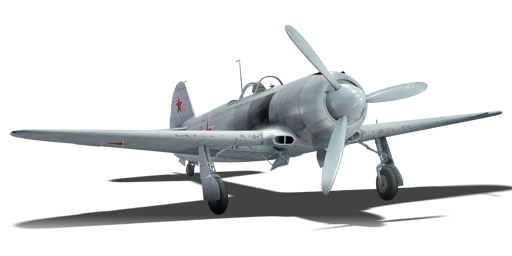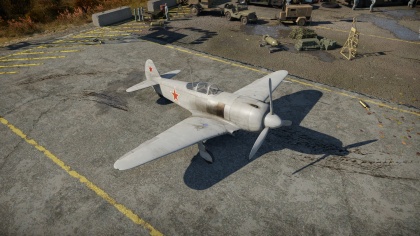Difference between revisions of "Yak-3U"
m (Added notice of BR discrepancy) |
Inceptor57 (talk | contribs) m (BR discrepancy fixed) |
||
| Line 1: | Line 1: | ||
| − | |||
{{Specs-Card|code=yak-3u}} | {{Specs-Card|code=yak-3u}} | ||
{{About | {{About | ||
Revision as of 14:56, 30 July 2019
Contents
| This page is about the Russian fighter Yak-3U. For other versions, see Yak-3 (Family). |
Description
The Yak-3U is a rank IV Russian fighter
with a battle rating of 5.7 (AB/RB) and 6.0 (SB). It was introduced in Update 1.89 "Imperial Navy".
General info
Flight performance
The Yak-3U is the pinnacle of the Yakovlev piston engined fighter design, combining the amazing agility of the Yak-3 airframe with the excellent Shvetsov M-82FN engine acquired from the Lavochkin line, increasing its top speed tremendously. One can expect a similar playstyle to the feared Yak-3P but turned up a few notches due to the improvement in speed. However, the big elephant in the room is the woefully inadequate armament for the tier; two B-20S 20 mm cannons mounted in the nose are unable to compete with other aircraft in the BR 6.3 range, or even other Soviet aircraft at the same tier such as the I-225. Thusly, the pilot should aim for critical components (engines, wings or pilot) in order to secure a kill.
| Characteristics | |||||||
|---|---|---|---|---|---|---|---|
| Stock | |||||||
| Max Speed (km/h at 6,000 m) |
Max altitude (meters) |
Turn time (seconds) |
Rate of climb (meters/second) |
Take-off run (meters) | |||
| AB | RB | AB | RB | AB | RB | ||
| 668 | 649 | 10500 | 18.2 | 19.4 | 21.6 | 21.6 | 360 |
| Upgraded | |||||||
| Max Speed (km/h at 6,000 m) |
Max altitude (meters) |
Turn time (seconds) |
Rate of climb (meters/second) |
Take-off run (meters) | |||
| AB | RB | AB | RB | AB | RB | ||
| ??? | 695 | 10500 | ??.? | 18.0 | ??.? | 26.5 | 360 |
Details
| Features | ||||
|---|---|---|---|---|
| Combat flaps | Take-off flaps | Landing flaps | Air brakes | Arrestor gear |
| X | X | ✓ | X | X |
| Limits | ||||
|---|---|---|---|---|
| Wing-break speed (km/h) |
Gear limit (km/h) |
Combat flaps (km/h) |
Max Static G | |
| + | - | |||
| 410 | ~11 | ~8 | ||
| Optimal velocities | |||
|---|---|---|---|
| Ailerons (km/h) |
Rudder (km/h) |
Elevators (km/h) |
Radiator (km/h) |
| < 380 | < 420 | < 490 | > 341 |
| Compressor (RB/SB) | ||
|---|---|---|
| Setting 1 | ||
| Optimal altitude | 100% Engine power | WEP Engine power |
| 1,550 m | 1,630 hp | 1,920 hp |
| Setting 2 | ||
| Optimal altitude | 100% Engine power | WEP Engine power |
| 4,550 m | 1,430 hp | N/A |
Survivability and armour
- 64 mm sloped bulletproof glass behind the pilot
- 8.5 mm steel plate behind the pilot seat
Armaments
Offensive armament
The Yak-3U is armed with:
- 2 x 20 mm B-20S cannons, nose-mounted (120 rpg = 240 total)
Usage in battles
Being an improvement on the Yak-3P, one can expect a similar playstyle to the feared Red Russian Menace, but with more versatility thanks to the improved engine providing a large increase in speed. The -3U provides quite a unique experience, as it can outturn the enemies it can't outspeed and it can outspeed the enemies it can't outturn, and a smart pilot will use this versatility to their advantage. One should stick with energy fighting for the most part, but Boom-&-Zoom on slower aircraft and turn-fight with less manoeuvrable opponents.
The one achilles heel of the 3U is the poor armament. The two B-20S cannons provide lacklustre stopping power at this tier and have a nasty habit of sparking and to top it off they have a very low ammunition count, only 120 rpg. The solid performance combined with the weak armament makes the -3U a very volatile plane. A newer or inexperienced player may find the performance enticing, but will struggle to do well if they're too trigger happy and not used to the Russian 20 mm's. However, a good pilot will be able to use the upsides to these cannons (accuracy, high rate of fire and ability to start fires) to their advantage.
Manual Engine Control
| MEC elements | ||||||
|---|---|---|---|---|---|---|
| Mixer | Pitch | Radiator | Supercharger | Turbocharger | ||
| Oil | Water | Type | ||||
| Not controllable | Controllable Not auto controlled |
Controllable Auto control available |
Controllable Auto control available |
Separate | Controllable 2 gears |
Not controllable |
Modules
| Tier | Flight performance | Survivability | Weaponry | |
|---|---|---|---|---|
| I | Fuselage repair | Radiator | Offensive 20 mm | |
| II | Compressor | Airframe | ||
| III | Wings repair | Engine | New 20 mm cannons | |
| IV | Engine injection | Cover | ||
Pros and cons
Pros:
- Reasonably quick thanks to the new engine
- Amazing manoeuvrability that can compete with almost every aircraft at the tier
- Solid climb rate
- Fast firing and accurate cannons concentrated in the nose that are extremely devastating in short, well-aimed bursts at close range
- High dive speed for a Russian prop
- Great acceleration
Cons:
- Still slow compared to its contemporaries
- Airframe is quite weak
- Susceptible to fires
- Twin cannon setup provides extremely poor ballistics at this tier
- Despite the high dive speed for a Russian prop, it's still not enough to keep up with most other fighters.
- No front mounted bulletproof glass
- Very limited ammunition load combined with the fast fire rate makes a trigger happy player run out of ammo very quickly
History
The last piston-engined fighter to be produced by Yakovlev was the Yak-3U. Retaining the light alloy stressed-skin metal wing and tail surfaces of the second-generation Yak-3, it mated these elements with an entirely new fuselage and an ASh-82FN 14-cylinder two-row radial engine rated at 1,850 hp. The engine was extremely close cowled, careful attention was given to the hermetic sealing of the fuselage. Armament consisted of twin synchronized 20 mm B-20 cannons, these were interchangeable with a pair 23 mm NS-23 cannons. The Yak-3 was considered to be the best low altitude (below 13,000 feet) fighter of WWII and could easily out climb, outrun and out turn its two major adversaries, the Bf 190 and Fw 190. With its 20 mm cannon it also could destroy any of the German tanks of that era. The Yak-3U replaced the V-12 engine of the earlier Yak-3s with a 1,850 HP radial along with many other changes. The Yak-3U first flew in May 1945, but with the end of the war and development of jet-powered aircraft, it was not put into production.
Media
Excellent additions to the article would be video guides, screenshots from the game, and photos.
See also
External links
| USSR fighters | |
|---|---|
| I-15 | I-15 WR · I-15 M-22 · I-15 M-25 · I-15bis · Krasnolutsky's I-15bis |
| I-153 M-62 · Zhukovsky's I-153-M62 · I-153P | |
| I-16 | I-16 type 5 · I-16 type 10 · I-16 type 18 · I-16 type 24 · I-16 type 27 · I-16 type 28 · I-180S |
| I-29 | I-29 |
| I-185 | I-185 (M-71) · I-185 (M-82) |
| I-225 | I-225 |
| ITP | ITP (M-1) |
| MiG-3 | MiG-3-15 · MiG-3-15 (BK) · MiG-3-34 |
| LaGG | I-301 · LaGG-3-4 · LaGG-3-8 · LaGG-3-11 · LaGG-3-23 · LaGG-3-34 · LaGG-3-35 · LaGG-3-66 |
| La | La-5 · La-5F · La-5FN · La-7 · Dolgushin's La-7 · La-7B-20 · La-9 · La-11 |
| Yak-1/7 | Yak-1 · Yak-1B · Yak-7B |
| Yak-3 | Yak-3 · Eremin's Yak-3(e) · Yak-3P · Yak-3T · Yak-3U · Yak-3 (VK-107) |
| Yak-9 | Yak-9 · Yak-9B · Golovachev's Yak-9M · Yak-9T · Yak-9K · Yak-9U · Yak-9UT · Yak-9P |
| Other countries | ▂P-40E-1 · ▂P-47D-27 · ▂Hurricane Mk IIB · ▂Fw 190 D-9 · ▂Spitfire Mk IXc |
| P-39 | ▂P-39K-1 · ▂Pokryshkin's P-39N-0 · ▂P-39Q-15 |
| P-63 | ▂P-63A-5 · ▂P-63A-10 · ▂P-63C-5 |





